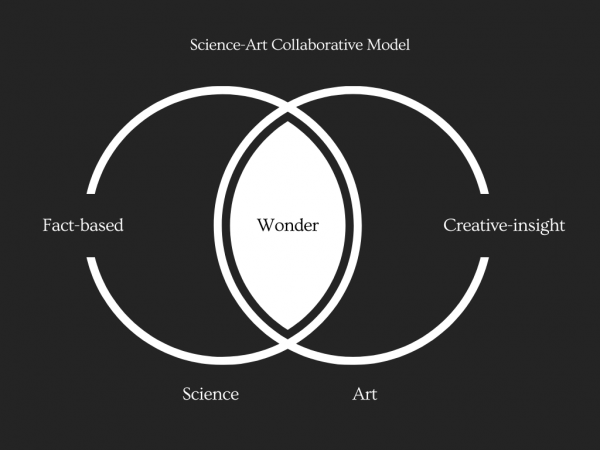Art is a knowledge-driven field, while science is an area that contributes significantly to our society and is a pillar of contemporary culture. Therefore, artists and scientists are often following common paths: from exploration to research, followed by production, delivery and sharing with their communities and broader society. Collaborations between scientists and artists are underway around the world in various ways, such as 1) inspiration based, 2) scientific understanding of creativity, 3) artists impressions of scientific work, 4) interdisciplinary collaborations, to name a few. This merge of science and art domains are reflected on #SciArt hashtag in fresh and exciting ways.
Earth-Life Science Institute (ELSI) at the Tokyo Institute of Technology as a world-leading institution to discover the “origins of the Earth and life” through an integrated interdisciplinary approach hosts a collective of top scientists and students from a variety of backgrounds. This allows ELSI to bring a unique perspective for science-art collaborations.

OUTREACH AND COLLABORATIONS
ELSI science-art programme focuses on collaborations between scientists and artists, with an outcome for outreach with the public at large. The approach puts ELSI scientists to look at their work in an artistic direction, and artists observe ELSI scientific process. This collaboration works as a two-way stream between scientists and artists through dialogue and understanding. The programme could present the outcome in a variety of ways as artwork, workshops or discussions.
ELSI PR Office works with one or more scientists and artists for each Science-Art project led by ELSI. The process of each effort can vary depending on the collaborations. Examples of such collaborations are; dialogue between scientists-artists, introducing artistic workflow to scientists, collaborative sessions to produce a physical artwork, etc.
ARTIST RECRUITMENT for FY2023
The project invites one artist to collaborate with one or more ELSI scientists. The collaboration process will give the artist access to certain areas (office and labs) of ELSI premises and tools to work with. The artist is expected to deliver a workshop/seminar to present their approach to developing an artwork, continue dialogue with scientists, and produce an artwork that will be displayed in the ELSI ‘Science-Art Wall’ in the ELSI building. End of the collaboration, the artist should produce a report/article explaining the collaboration process that will be published on the ELSI website.
The theme of the project this year is ‘Complex Systems in Origins of Life’. The selected artist is expected to explore this theme through collaboration with ELSI scientists, and output it in the final art work using their own artistic interpretation.
The artist is welcome to use the ELSI visitor’s room for work and collaboration with the scientists. Costs involved in production will be covered by ELSI. The outcome of the collaborations, articles, photos, videos, artwork, etc., will be a property of the ELSI, Tokyo Institute of Technology.
DELIVERABLES
- Workshop/seminar to present the process of art production to scientists
- Discussion between collaborating scientists
- Outcome of the collaboration in art medium (e.g., painting, design, photography, etc.)
- Final report/article that will be published on ELSI website
SELECTION GUIDELINES
- Period of the project is October 2023 – February 2024.
- The candidate is required to have a working-knowledge of English.
- Must be a resident and based in Japan during the period of the project.
- The candidate must have an art medium to create an artwork that can be mounted on a wall as an exhibit.
- The candidate is accepted to visit ELSI a few times during the project period.
- The candidate will be selected by the ELSI PR Office through a review process.
Apply through the following form: https://forms.gle/6uvvYTuciTpL3F99A
Deadline is on 11 September, 2023. (Deadline extended on August 28)
